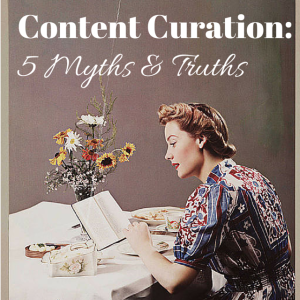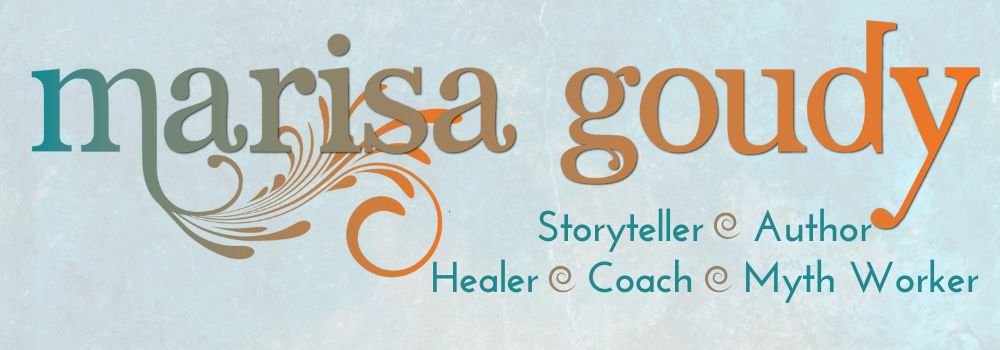 Content curation seems like an easy way to boost your online visibility and prove you're a useful, fascinating resource.
You pull together ideas from lots of smart people and then weave them together with a common thread plucked from your own life and work. You publish and share. You tag both the new and established content creators who are featured in your piece. Take the weekend off and start it all over again on Monday.
Content curation seems like an easy way to boost your online visibility and prove you're a useful, fascinating resource.
You pull together ideas from lots of smart people and then weave them together with a common thread plucked from your own life and work. You publish and share. You tag both the new and established content creators who are featured in your piece. Take the weekend off and start it all over again on Monday.
I took it on good authority that this whole curated newsletter thing was a low sweat way to build credibility. And grow a list.
5 Myths and Truths About Content Curation for the Creative Entrepreneur
 This list is based on ten weeks’ experience of research and writing about 15,00 words. Is this enough time to be an expert in the field of curated newsletters? No, but I am an authority on the Sovereign Standard and my own definition of what it means to be a successful creative entrepreneur.
This list is based on ten weeks’ experience of research and writing about 15,00 words. Is this enough time to be an expert in the field of curated newsletters? No, but I am an authority on the Sovereign Standard and my own definition of what it means to be a successful creative entrepreneur.
My intention is to give you some insights from inside a content curation project because there’s a lot of good press about it out there.
Truth is, you might just be better off writing rather than curating. I’m pretty sure I am...
Myth #1: Content Curation is Quick and Easy
The Hope: Curating others’ content would be easier and faster than writing my own post/newsletter each week.
The Truth: Weaving together other people’s posts and interviews often took more time than just writing and organizing my own ideas. Though I started with three set categories (livelihood, message, and everyday creative magic) and intended to share a couple of posts for each, I quickly rejected what felt like an overly simplistic system and wrapped all the ideas together in prose. (Lots and lots of prose...)
Outcome: I was producing long, “heady” posts each week that were well-made but ultimately too much for the majority of my readers.
Myth #2: Content Curation Makes You Smarter
Hope: I would read more widely and with more focused attention.
The Truth: I stopped reading things for pleasure or personal growth and would scan only for Sovereign Standard-related ideas. It’s likely I missed out on the best stuff because I was preoccupied with my agenda - my topic of the week.
Outcome: Reading others’ content became a chore. And, for brief and terrible periods, I started playing Two Dots or Candy Crush to avoid it.
Myth #3: Content Curation Encourages People to Share the Posts
Hope: Content creators would be so happy to appear in the Sovereign Standard that they’d jump on my list and share the posts with enthusiasm.
The Truth: Some people were awesome about this. Heck, Margaret Atwood tweeted at me and must have visited my blog (because she thought I misread her poem, but still…)! For the most part, however, there wasn’t any detectable bounce from all my dedicated linking and tagging.
Outcome: Over this ten week period I was producing two posts a week. The post that was all “mine” and more directly related to writing advice was just as likely to be shared as the Sovereign Standard piece.
Myth # 4: If It’s a Good Idea, It’s Worthy of Content Curation
Hope: Great posts related to the week’s topic would be easy to share and link to.
The Truth: The Sovereign Standard is about setting one’s own standards. Everything that was included in an issue had to meet my own (rather exacting) standards. As a writing coach with extensive website creation experience, I size up the effectiveness and quality of a site in about three seconds flat. I had to reject lots of content related to my weekly topic because I didn’t think the post or the site worked overall. If the post didn’t include a clear call to action or the website left me wondering “what does this person actually do?” I couldn’t include it.
Outcome: I did identify some potential clients and I became certain that people need my help when it comes to clarifying their message and presenting it through clear website copy. (Yes, this ultimately is a win, but it never made assembling the Standard any easier!)
Myth #5: Content Curation Frees Me to Focus on My Own Creative Projects
Hope: As in point #1, I was seeking a quick and easy route to visibility because I have a novel to write (and children to mother and a husband to love and clients to serve).
The Truth: Because content creation didn’t really feel like mine (even though I was expending loads of creative energy as I tied all those ideas and sources together), I felt compelled to write a second blog post each week that explored my signature idea - Writing to Sovereignty. The novel? I’d be lucky if I made few notes while nursing or hanging at the playground. Those two blog pieces took all my writing and production mojo.
Outcome: I started to feel like a fraud calling myself an “author” when I hadn’t typed a word of fiction since launching this curated newsletter. I was starting to resent whomever had appropriated my creative fire… and I realized it was me.
Still Curating, Still Sending a Newsletter, Just Not a Curated Newsletter
When it comes down to it, there is nothing wrong with content curation. I’ll never actually stop doing it.
After all, every time you share something you’re a “curator.” And linking to other people’s posts is a longstanding tenet of blogging that deserves to be preserved.
The problem was the way that I went about it. I lavished time and attention I didn’t really have on a project that wasn’t giving back what I was putting in.
The hope was to create something credible and substantial. The truth was, I believed that no one would be interested in what Marisa Goudy had to say about writing, entrepreneurship, and creativity, so I decided to share the spotlight with other creatives (many of whom hadn’t asked for the privilege).
I was afraid to stand Sovereign.
I’m grateful for this 10 week journey - for all that it has taught me and for managing to fail quickly (to borrow Chris Brogan’s line). I’m taking this opportunity to reset my course so I can tell my own Sovereign Story and offer you, dear reader, something useful that will help you identify your own.
Focus On What Actually Builds Visibility & Brings in Clients
What will change about the Sovereign Standard? Even my most loyal readers may barely notice.
The important thing is that I am shedding a term that became heavy and restrictive for me. I wanted “curated” to be a container that helped me shape my thoughts easily each week. Instead, I was perpetually over-delivering (in ways that didn’t add tangible value to readers or boost my business) because that container was never the right size or shape.
Likely I’ll end up blogging on my own site once a week and focusing on guest posting (please go read my essay about grief, motherhood, and a crazy dog on Suzi Banks Baum's Laundry Line Divine).
Most importantly, I’ll be making my foundational website copy absolutely perfect so no one ever says “I love your work! But… what exactly do you do?”
Need help focusing in on what writing projects are really important to building your business? Let's set up a free initial consultation.





